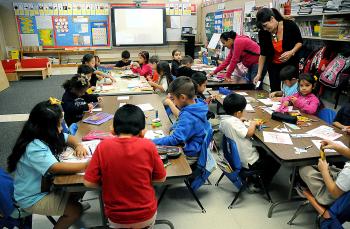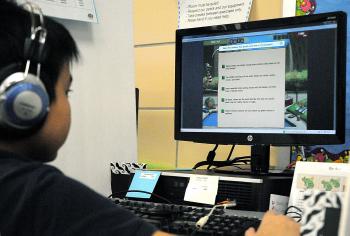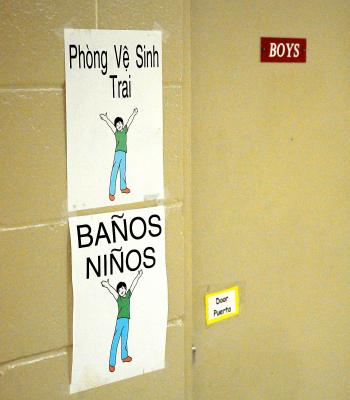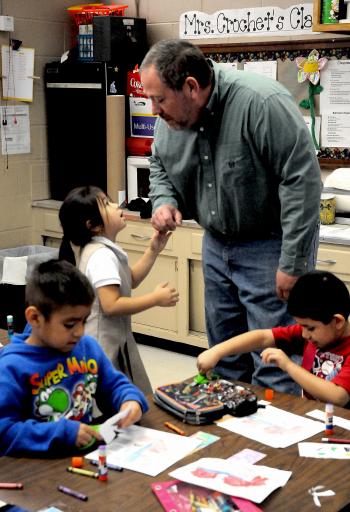



Educators overcome language hurdles
Mon, 2013-10-28 14:15
Harlan Kirgan
In 2001, about 42 percent (of students) were Vietnamese. Here, we’ve transitioned from predominately Vietnamese to a predominately Hispanic population.
Amelia, La.
By JEAN L. KAESS
jkaess@daily-review.com
With 70 percent of its students being of Hispanic or Vietnamese ethnicity and a full 40 percent of the total school population identified as lacking in English proficiency, J.S. Aucoin Elementary School has had to do things a little differently.
Principal Joe Stadalis said his school has taken a number of steps to assist its students including implementing numerous language programs and employing several translators.
The state Department of Education says students who are learning English as a second language are assessed annually using the English Language Development Assessment. The assessment measures proficiency in listening, speaking, reading, writing and comprehending English.
“What’s making it work out here? I’ve got the right people doing the right things. It’s a total team effort,” Stadalis said.
Everything from moving Fast ForWord — a reading intervention program that strengthens brain processing and literacy skills — to lower elementary grades, to placing simple words on the walls in three languages is utilized.
“In 2001, about 42 percent (of students) were Vietnamese. Here, we’ve transitioned from predominately Vietnamese to a predominately Hispanic population. In all essence, we’ve only had a couple blips on radar where (school performance scores) have gone down, but we’ve made steady gains,” Stadalis said.
In the recently released school performance scores, J.S. Aucoin was rated as a B school.
“The gaps we close are much bigger because of the language issue,” Stadalis said.
Typically it takes two to three years to develop conversational English, then academic English kicks in, he said. In another three or four years, students “really hone in on academic English,” Stadalis said.
Finally, as students get older, usually in seventh or eighth grade, they start mastering academic English, he said.
Both Stadalis and Sharisse Crochet, a kindergarten teacher in her 11th year working at J.S. Aucoin, said it’s more difficult for Vietnamese students than Hispanic students.
“I think that the Vietnamese, it was probably a little more difficult for them and for us just because it’s a much harder language. … They do have some similarities with Spanish where sometimes they can tell me something and I might understand what they’re saying. But Vietnamese, that’s a whole different ballgame. Luckily then we had Vietnamese aides. That was very helpful at that time.”
Stadalis said the population shift between the two cultures occurred shortly after Hurricane Katrina in 2005.
He believes many Vietnamese moved out of the community to take jobs elsewhere. Add that many of J.S. Aucoin’s students are the third generation of their families to learn English, and the factors account for the lower ESL (English as second language) numbers. There’s still a good size Asian population in Amelia though, Stadalis said.
The challenges continue for Hispanic students, their parents and their teachers.
“It is difficult, especially in the lower grades. When they come to school in the lower grades they have to adapt socially as well as academically. Well, these children also have to learn a different language,” Crochet said.
The students speak Spanish at home, and they have trouble doing homework
“They don’t know the language well enough, and their parents can’t help them with their work,” Crochet said.
There are three official translators in the school — Maria Ledezma, Lorena Martinez and Angelica Zavala — plus the school secretary, Teresa Quintanilla, who fills in when needed.
Phone calls home and parent-teacher conferences are handled by the aides who assist with translation and a bit of patience as the teachers wait their turns to share those translators. Crochet estimated 80 percent of the parents only speak Spanish.
“So, we have to have the translators. It’s the only way for us to communicate with them,” Crochet said.
Sixteen of her 24 students lack English proficiency, which identifies them as ESL students.
In her classroom, Crochet resorts to everything from pictures on the computer to teach English words and flash cards to an application on her phone if she can’t find a translator.
While schools across the parish have seen increased numbers of ESL students, J.S. Aucoin has had the largest influx.
Superintendent Donald Aguillard said the English as a second language population represents nearly 10 percent of all students. The group requires additional services to facilitate transition to fluency in the English language.
In September, the school system hired four additional limited English proficiency paraprofessionals to serve nine schools.
Students receiving English as a second language services, by school are:
—J.S. Aucoin, 86 Hispanic, 22 Vietnamese.
—Bayou Vista Elementary, 18 Hispanic, 2 Chinese.
—Berwick Elementary, 17 Hispanic, 2 Vietnamese, 1 Malaysian.
—Berwick Junior High, 7 Hispanic.
—Berwick High, 9 Hispanic, 1 Malaysian.
—Centerville, 2 Hispanic.
—Foster Elementary, 9 Hispanic.
—Franklin Junior High, 4 Hispanic, 1 Arabic.
—Franklin High, 7 Hispanic.
—LaGrange Elementary, 5 Hispanic, 4 Arabic.
—Maitland Elementary, 14 Hispanic.
—Morgan City Junior High, 44 Hispanic, 5 Vietnamese, 1 Malaysian.
—Morgan City High, 39 Hispanic, 8 Vietnamese.
—Patterson Junior High, 9 Hispanic.
—Patterson High, 6 Hispanic.
—M.D. Shannon Elementary, 14 Hispanic, 1 Malaysian.
—Hattie Watts Elementary, 4 Hispanic, 1 Vietnamese, 1 Chinese.
—Wyandotte Elementary, 19 Hispanic, 2 Vietnamese.
—Norman Elementary, 18 Hispanic, 4 Vietnamese.
—B.E. Boudreaux Middle, 1 Arabic.
—West St. Mary High, 1 Arabic.
Aguillard said the total racial breakdown in school system is 4,474 or 47.2 percent white; 3,942 or 41.7 percent black; 777 or 8.2 percent Hispanic; 176 or 1.9 percent Asian; and 50 or 0.5 percent American Indian.
- Log in to post comments
